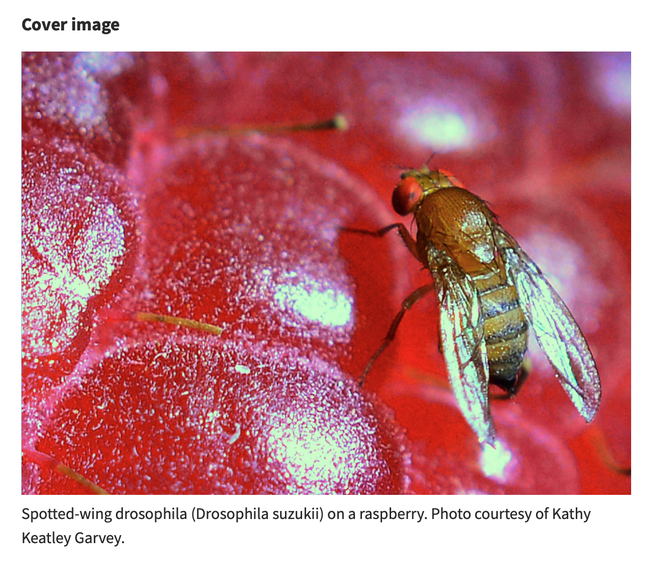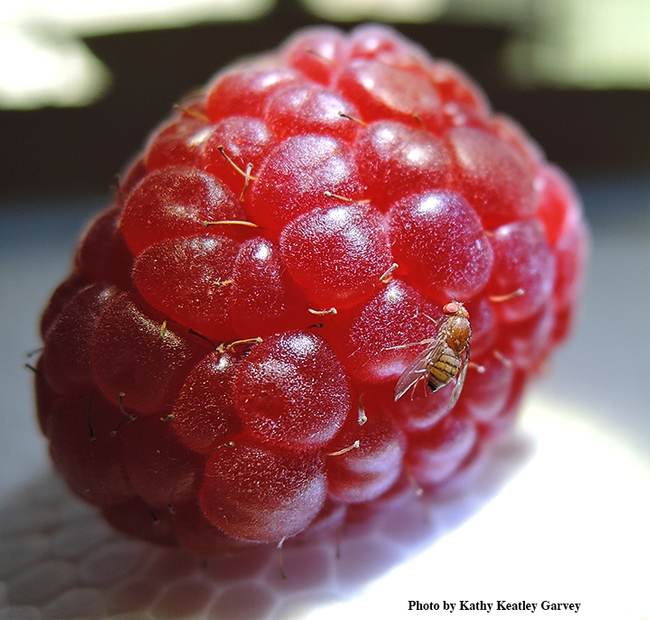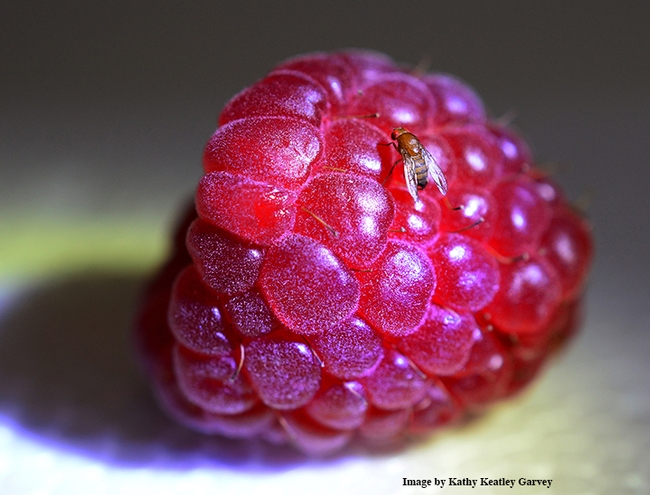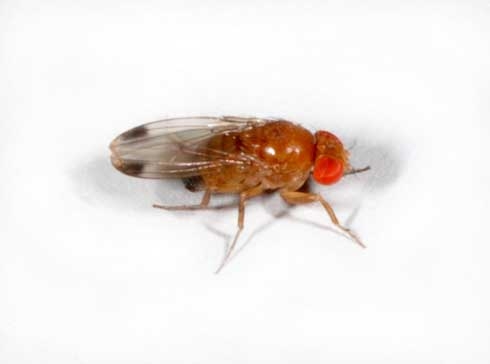Posts Tagged: Drosophila suzukii
ESA Journal Targets the Spotted-Wing Drosophila
It was a major project, a long time coming, and what an excellent resource for those studying the spotted-wing drosophila, a worldwide threat to the...

The Cover
Zeroing in on the Spotted-Wing Drosophila
It's an invader that has long attracted attention--and alarm--in California agriculture. "The spotted-wing drosophila, Drosophila suzukii,...

UC Davis postdoctoral researcher Brian Gress will discuss "Host Selection and Resistance Evolution in Drosophila Suzukii" at a UC Davis Department of Entomology and Nematology seminar at 4:10 p.m., Wednesday, Jan. 9 in 122 Briggs Hall.
UC Davis Seminars: From Spotted Wing Drosophila to Spider Glue to Wild Bees
From spotted wing drosophila to spider glue to wild bees! Medical entomologist Geoffrey Attardo, assistant professor, UC Davis Department of...

Spotted-wing drosophila on raspberry. (Photo by Kathy Keatley Garvey)
Kent Daane Seminar: Spotlight on Spotted Wing Drosophila
(Editor's Note: If you missed the seminar, you can view it here on YouTube at https://youtu.be/KVTGmDo2LLQ). Recorded by George Terry of UC Davis...

Spotted Wing Drosophila, Drosophila suzukii, on raspberry. (Photo by Kathy Keatley Garvey)
Spotted Wing Fruit Fly
Last month I wrote a blog about a method of protecting our cherry crop from hungry birds (once we had gotten the upper hand on the Spotted Wing Fruit Fly). Two comments that followed my blog asked about how we were able to protect our Lapin cherries from the darned “cherry maggots”. Hence the topic of this blog!
An excellent management guideline for Drosophila suzukii, aka Spotted Wing Drosophila (SWD) or Spotted Wing Fruit Fly can be found at http://ipm.ucdavis.edu/PMG/PESTNOTES/pn74158.html. Check it out and discover everything you always wanted to know (or maybe not know) about SWD!
This serious pest, originally from Japan, was first found in 2008 in California as it went about damaging RIPENING cherries and berries. Alarming! -given that other fruit flies typically infest rotting or fermenting fruit. Turns out that the female SWD’s ovipositor can saw into unripe cherries and allow her to lay her eggs. Because SWD is a relatively new pest, research about its life cycle and management is ongoing. At present, these are the recommendations which we have followed in our garden, and the results have been good.
Monitoring – Before launching an attack on SWD, be sure that it is actually present in your susceptible trees or berry plants. You can make an effective monitoring trap from a plastic 1 quart yogurt container with a lid. Just drill 10 to 16 holes that are 3/8 inch in diameter around the top part of the container, just below the lid. Bait the trap with 1 to 2 inches of pure apple cider vinegar and a drop of unscented liquid dish soap. Hang a few traps in the shade of your cherry tree or near berry plants in late April or early May, when temperatures have reached 60 to 80 degrees. Check traps weekly or so and look for small drowned male SWDs which have dark spots on the tips of their wings.
Chemical Control – If you find SWD males, consider spraying with spinosad (e.g., Monterey Garden Insect Spray). This insecticide has the least negative impact on the environment and is effective in controlling SWD. Timing is very important – spraying has to be done just as the cherries turn from yellow to pink or about 2-3 weeks before harvesting. In this window of time, adult flies can be killed before they are able to lay eggs in the fruit. A second application can be done in 7 to 10 days. Remember to carefully follow spraying directions and precautions as per the label.
Cultural Control – To reduce the worry of infestation of next year’s crop, be sure to clean up any fruit on the ground or left in trees. Seal it in a sturdy plastic bag and dispose of it in the garbage. Or solarize the fruit by placing it under clear plastic in the sun. This will effectively kill the flies.
The information given in the suggested UC website is much more detailed. Should you have further questions, we Master Gardeners will be happy to help find the answers. These management efforts take a bit of time and attention, but for me personally it has been well worth it!

Adult male spotted wing drosophila. (Photo by Martin Hauser)

